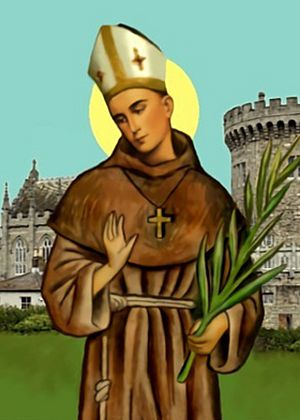Concobhar Ó Duibheannaigh facts for kids
Quick facts for kids The Blessed Concobhar Ó Duibheannaigh, O.F.M. |
|
|---|---|
| Bishop of Down and Connor | |
| Diocese | Down and Connor |
| Appointed | 27 April 1582 |
| Reign ended | 1 (O.S.)/11 (N.S.) February 1612 |
| Predecessor | Donatus Ó Gallchobhair (bishop) |
| Successor | Patrick Hanratty (vicar apostolic) |
| Orders | |
| Consecration | 2 February 1583 by Nicolas de Pellevé |
| Personal details | |
| Birth name | Concobhar Ó Duibheannaigh |
| Born | c. 1532 Drumkeen, Raphoe, County Donegal |
| Died | 1 (O.S.)/11 (N.S.) February 1612 (aged c. 80) Dublin |
| Nationality | Irish |
| Denomination | Roman Catholic |
| Sainthood | |
| Feast day | 20 June |
| Venerated in | 6 July 1991 |
| Beatified | 27 September 1992 Rome by Pope John Paul II |
Concobhar Ó Duibheannaigh (born around 1532 – died February 11, 1612) was an Irish Catholic bishop. He is known as a martyr, which means he died for his religious beliefs. He is also called Conor O'Devany or Cornelius O'Devany. The Catholic Church has formally recognized him as "Blessed."
Contents
Early Life and Becoming a Bishop
Conor O'Devany was born in Malin Head, County Donegal, in Ireland. He studied to become a Franciscan friar at Donegal Abbey in Donegal Town.
While he was in Rome, Pope Gregory XIII chose him to be the Bishop of Down and Connor. This happened on April 27, 1582. He officially became a bishop on February 2, 1583. Cardinal Nicolas de Pellevé performed the ceremony.
Challenges and Arrests
In 1588, Bishop Ó Duibheannaigh was sent to Dublin Castle, which was a prison. The authorities tried to find a crime he had committed that was serious enough for him to be executed. However, they could not find one.
The leader of Ireland at the time, Lord Deputy William Fitzwilliam, wanted to get rid of him. He asked for permission to deal with Ó Duibheannaigh, calling him an "obstinate enemy of God" and a "traitor."
Bishop Ó Duibheannaigh stayed in prison until November 1590. He was then released, possibly because he asked for it, or perhaps for political reasons.
Years of Protection
After his release, Bishop Ó Duibheannaigh was protected by Hugh O'Neill, Earl of Tyrone. This protection lasted until 1607, when many Irish leaders, including O'Neill, left Ireland in an event known as the Flight of the Earls.
Bishop Ó Duibheannaigh managed to avoid being arrested again until the middle of 1611. By then, he was almost 80 years old. He was arrested while he was performing a religious ceremony called Confirmation. He was once again taken to Dublin Castle.
The execution of Bishop Ó Duibheannaigh was strongly desired by the Lord Deputy of Ireland, Sir Arthur Chichester. Chichester was very against the Catholic faith. It seems that the government as a whole was not as eager for the execution as Chichester was.
Trial and Martyrdom
On January 28, 1612, Bishop Ó Duibheannaigh was put on trial. He was accused of high treason, which means betraying the government. The jury was chosen carefully, and most of them found him guilty. He was sentenced to die on February 1, according to the calendar used at the time.
He was taken from Dublin Castle to the place of execution. Many Catholics gathered along the way. Protestant religious leaders tried to get him to say that he was dying because he was a traitor. He told them to leave him alone. He pointed to a building and said that the viceroy's messenger had offered him his life and money if he would just go to that church once.
Before he was executed, he kissed the gallows. He then encouraged the Catholics watching to stay strong in their faith. He was executed by hanging.
Patrick O'Loughran
A priest named Patrick O'Loughran, who had been arrested in Cork, was executed with Bishop Ó Duibheannaigh.
After the execution, people tried to take pieces of his clothes and even parts of the gallows. They prayed all night near his remains. It was said that a sick man was cured by touching them. So many people came to pray that the viceroy ordered the remains to be buried quickly. However, the next night, Catholics dug them up and buried them properly in St. James's Churchyard.
Bishop Ó Duibheannaigh had made a list of other martyrs. This list was later used by Bishop David Rothe in his writings.
Beatification
On September 27, 1992, Bishop Ó Duibheannaigh was formally declared "Blessed" by Pope John Paul II in Rome. He was one of sixteen people known as the Irish Catholic Martyrs who were beatified that day.
The Feast Day for the Irish Martyrs is celebrated every year on June 20.
See also
- Irish Catholic Martyrs


